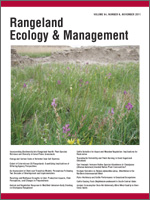Rangeland extent is an important factor for evaluating critical indicators of rangeland sustainability. Rangeland areal extent was determined for the coterminous United States in a geospatial framework by evaluating spatially explicit data from the Landscape Fire and Resource Management Planning Tools (LANDFIRE) project describing historic and current vegetative composition, average height, and average cover through the viewpoints of the Natural Resources Inventory (NRI) administered by the Natural Resources Conservation Service and the Forest Inventory and Analysis (FIA) program administered by the US Forest Service. Three types of rangelands were differentiated using the NRI definition encompassing rangelands, afforested rangelands, and transitory rangelands. Limitations in the FIA definition permitted characterization of only two rangeland types: rangeland and rangeland vegetation with a small patch size. These classes were similar to those from the NRI definition but differed in tree canopy cover threshold requirements. Estimated rangeland area resulting from the NRI- and FIA-LANDFIRE models were 268 and 207 Mha, respectively. In addition, the NRI-LANDFIRE model identified 19 Mha of afforested rangelands due principally to encroachment and increased density by species classified as trees belonging to the genera Quercus, Prosopis, and Juniperus. The biggest discrepancies between acreage estimates derived from NRI- and FIA-LANDFIRE models occurred in oak, pinyon-juniper, and mesquite woodlands. The differences in area estimates between the NRI and FIA perspectives demonstrate the need for development of unified, objective methods for determining rangeland extent that can be applied consistently to all rangelands regardless of ownership or jurisdiction. While the models and geospatial information developed here are useful for national-scale estimates of rangeland extent, they are subject to the limitations of the LANDFIRE data products.
How to translate text using browser tools
1 November 2011
Extent of Coterminous US Rangelands: Quantifying Implications of Differing Agency Perspectives
Matthew Clark Reeves,
John E. Mitchell
ACCESS THE FULL ARTICLE
GIS
LANDFIRE
rangeland area
rangeland classification
rangeland cover





